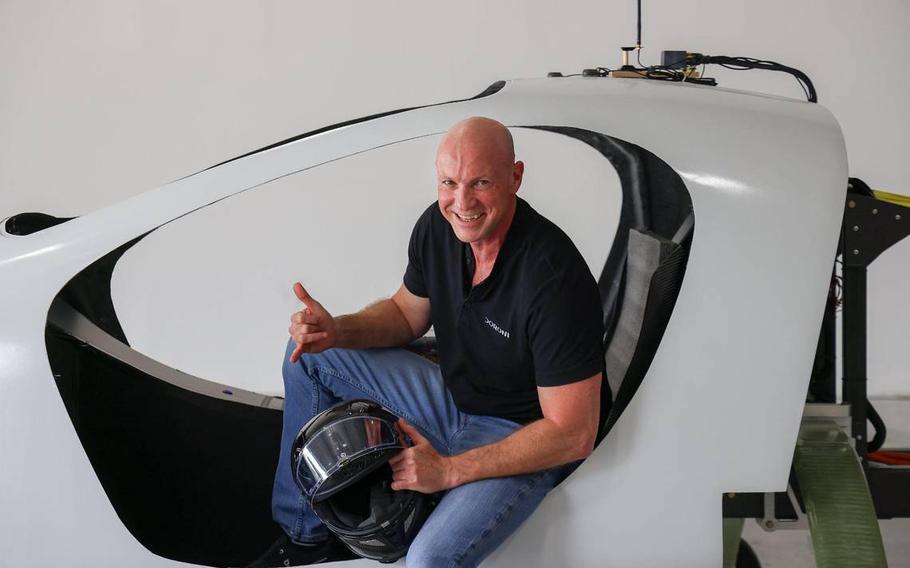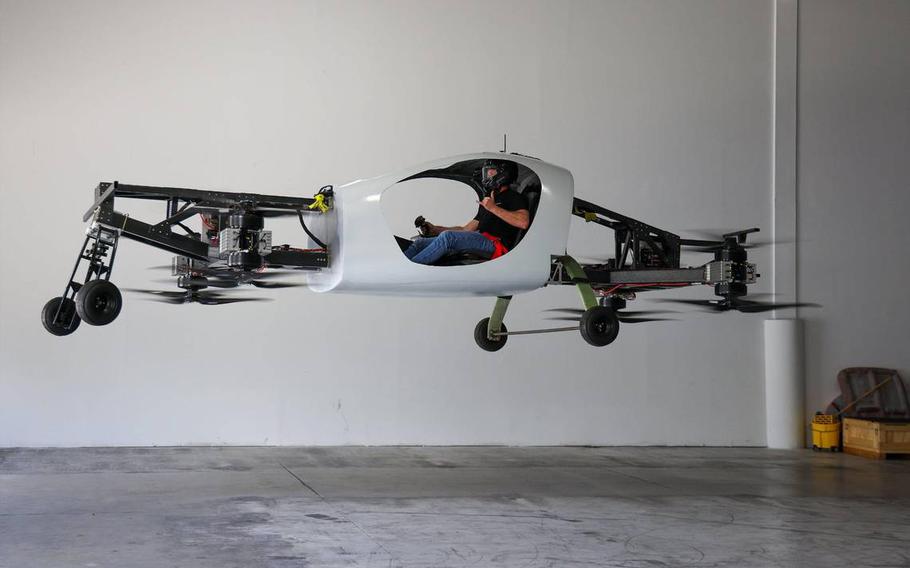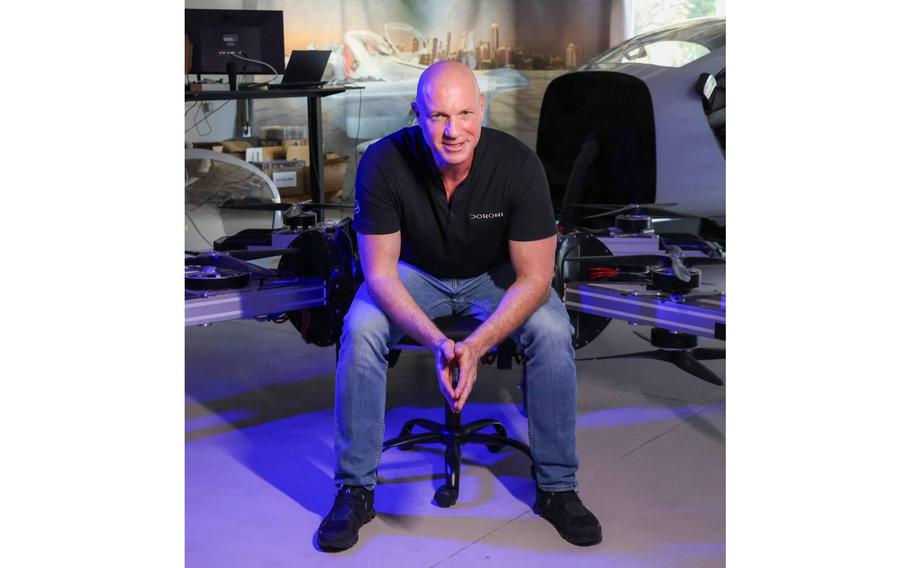
Doroni Aerospace CEO Doron Merdinger gives a thumbs up after taking flight in the latest version of his company’s flying car at Doroni Aerospace’s Pompano Beach, Fla., offices, Monday, July 3, 2023. (Carl Juste, Miami Herald/TNS)
(Tribune News Service) — On a sunny Monday in July at a Pompano Beach, Fla., office park, Doroni Aerospace’s small team walked to the back of the company’s lab into an aircraft hangar big enough to fit a couple of Boeing 747 jets. But all that was in there was an odd plastic shell with four sets of propellers and a man sitting in it.
Suddenly, the team’s chatter stopped. A sound like a large lawn mower filled the hangar as the vehicle’s engine revved up. The pilot, Doroni Aerospace CEO Doron Merdinger, stuck his arm out the left side of the vehicle to signal thumbs up.
Steadily, the shell levitated 10 feet above the hangar floor. It swayed slightly side-to-side like a drone before gaining its balance and centering itself. Everyone looked on in silence.
It wasn’t a movie stunt. This is the fledgling South Florida company’s entry in a novel and increasingly competitive race to be one of the first to win federal approval and begin selling a product that has long been the stuff of science fiction.
Doroni Aerospace calls them “flying cars.” For the Federal Aviation Administration, which just released a plan to begin authorizing and regulating a new field of flight that it calls Advanced Air Mobility, they’re “air taxis” or, alternatively, “electric Vertical Takeoff and Landing” aircraft, eVTOL for short.
To the average observer, they might look similar to what they in fact are — oversized drones that carry human passengers. And no, Alice, this is no hallucination.
They’re about to become very much a reality.
“All of these sci-fi books that later became movies already predicted the future,” Merdinger said. “From flying to the moon to being able to see someone via a smartphone, these have already been happening. We knew flying cars were coming from ‘The Jetsons’ and ‘Fifth Element.’ The question is, what technology will make it happen?”
Soon, anyone who can afford a Ferrari could also own a Doroni flying car — price tag $300,000 — or competing models that manufacturers are racing to market in the U.S. and around the world.
“For so long, people thought of space and aerospace as being for a small subset of the population,” said Anna Alexopoulos Farrar, vice president of communication for Space Florida, a state agency that promotes aerospace economic development and has provided seed money for Doroni.
New competitive market
Doroni will have lots of competition.
Just last month, California company Alef got a lot of media attention when it announced that it passed FAA standards for its Model A, another two-passenger, $300,000 flying car that, unlike the Doroni model and most competitors, can also be driven on the street — albeit at a glacial top speed of 15 mph — and parked like a car. It’s not even the first to receive FAA certification, which for now allows operation only for exhibition and research and development.
But the FAA this week released an “implementation plan” to develop rules and standards for pilot qualifications and air-traffic control systems aimed at allowing the wide operation of what are essentially aircraft that take off and land like a helicopter. The goal is to have a well-regulated passenger-drone system in place by 2028. Eventually, if drone traffic is dense enough, the FAA said it could establish designated air corridors for them.

Doroni Aerospace CEO Doron Merdinger gives a thumbs up as he levitates in the latest version of his company’s flying car at Doroni Aerospace’s Pompano Beach offices, Monday, July 3, 2023. (Carl Juste, Miami Herald/TNS)
Set aside any notions for now of hopping in your passenger drone to get to work or out to the mall, however.
Initially, the FAA said, the system will work like the one for helicopters, with takeoffs and landings at existing airports, heliports or yet-to-be-developed “vertiports.” Pilots must be trained and rated to operate what the FAA calls powered-lift vehicles. And the FAA said it will also seek public input on the potential disturbance to humans, communities, nature and wildlife from having these vehicles fly over a neighborhood or across the countryside.
Still, Doroni officials said they’ve had plenty of interest from investors and potential buyers.
In the company’s first 14 months, it raised $3.6 million from investors after winning a competitive, $30,000 accelerator grant from Space Florida in 2021. But its flying car has been under development for longer, since 2016, and the company is looking to roll out its first vehicles in 2025. The company claims to have a long list of pre-orders with deposits.
The current prototype has completed 60 test flights, five with Merdinger at the two control sticks. Once Doroni Aerospace receives preliminary FAA approval, the flying car will be deemed safe and available for sale.
Is it like a helicopter?
The flying cars have electric motors instead of the gas-combustion engines usually found in airplanes. A carbon-fiber shell instead of the aluminum used for planes makes the flying cars lighter and more streamlined and efficient, Merdinger said. The flying vehicles will be nimbler and will maneuver far more precisely than heavier and more cumbersome alternatives such as helicopters, he said.
“The inspiration was Formula 1, but the more time that passed, we find it is between F1 and the hummingbird,” he said of the flying car. “It has to be aerodynamic. It’s humming, very accurate and nimble. There isn’t any other vehicle that size in the world to be flying that accurate. Helicopters and regular aircraft can’t do that.”
They need only space 1.5 times the length and width of the vehicle to land and fit in a two-car garage. The flying range is 100 miles. Merdinger insists they will be safe and reliable. If there is an emergency or malfunction, though, the vehicle’s cockpit has a rocket-powered parachute that can propel passengers away from the vehicle.
Merdinger, 55, studied computers as a high-school student in Israel before joining the Israeli Air Force and studying drone technology. He said he was fascinated by the flying cars in science-fiction movies such as “The Fifth Element” and wondered what it would take to make them happen in real life.
In 2013, Merdinger moved to Florida on a special-talent visa and later became a naturalized American citizen. In 2016, he launched Doroni Aerospace.
Now, he’s lining up paying customers, such as Port St. Lucie surgeon Jon Brown, 44, who envisions using his flying car to shorten his work commute.
Rules and insurance concerns might still need to be worked out, but Brown, who has a pilot’s license, said he is often on call at the hospital where he operates and can spend up to two hours on his commute. He lives at an airpark fly-in community with an airstrip nearby and a helipad at the hospital. He figures he could get from home to work in five minutes in a flying drone.
“I’ve been flying for 10 years,” he said. “Everyone at the airpark is super-excited about this thing.”
Where flying cars can help
The FAA says it sees multiple potential uses for the flying vehicles to carry cargo and passengers in situations where they could have advantages over existing aircraft. Those cases could include fighting fires and conducting search-and-rescue missions. The technology could also benefit underserved and rural communities, the agency says.
The target airspace for the flying car, the FAA says on its website, is 500-1,000 feet. Drones typically operate at 400 feet and below, while the minimum level of elevation for jets is 1,500. This would put the flying cars at a middle distance between existing drones that don’t carry people and big aircraft.

Doroni Aerospace CEO Doron Merdinger is photographed after taking flight in his company’s flying car at Doroni Aerospace’s Pompano Beach offices, Monday, July 3, 2023. (Carl Juste, Miami Herald/TNS)
Matt Gillio, who has farmed in California’s Santa Rosa Valley for 35 years, said he knew the Doroni drone could make his arduous work of growing avocados and other crops easier and more efficient. In addition to putting down a deposit on a flying car for himself, Gillio also invested in the company. He is an ardent believer in the company’s mission and sees these vehicles as less dangerous alternatives to helicopters.
“The reason it appealed to me is, I go out and check my fields every day,” he said. “To check all my fields takes most of the day. With one of these things, I can check all of these things in an hour. You can see a lot better in the air. I’ve checked fields via helicopter before, and you can check problems easier from overhead.”
John Wensveen, executive director of Nova Southeastern University’s Alan B. Levan | NSU Broward Center of Innovation and a 30-year aviation-industry veteran, said flying vehicles such as Doroni’s can help overcome traffic congestion and aid military operations.
“There are air-ambulance applications for emergency services, and the greatest application is in the world of the military,” he said. “A lot of emerging technologies are implemented in the military first. Doroni Aerospace has a huge opportunity to serve military needs for tech.”
In 1999, Wensveen worked with NASA on a project that envisioned everyone having flying cars some day. The future is here, but rather than NASA at the controls, it’s private companies, such as Doroni Aerospace, he noted.
Merdinger said he has been captivated by the technology in the “Iron Man” movies and believes that just as flying robotic suits are normal in that world, flying cars will become commonplace in this one.
“In five to 10 years, this will become more of the norm,” Merdinger said.
©2023 Miami Herald.
Visit miamiherald.com.
Distributed by Tribune Content Agency, LLC.